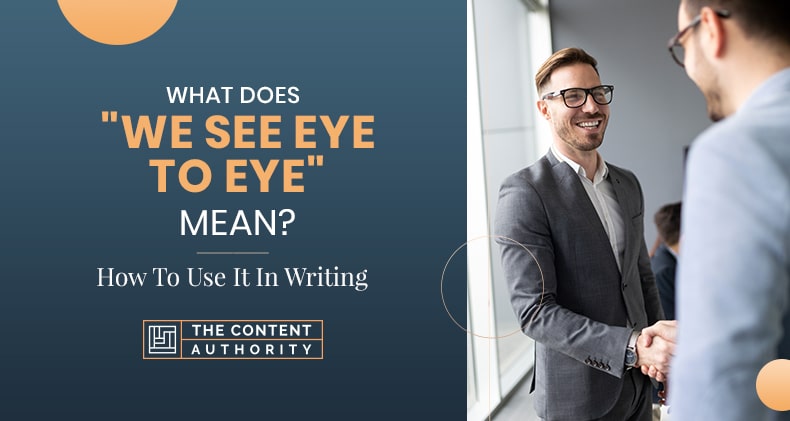While there are many phrases, terms, and idioms in the English language, some of them have been around for thousands of years, and others have surfaced fairly recently. One such idiom that goes way back thousands of years is “we see eye to eye.” So let’s explore this idiom to reveal its meaning and usage in the English language.
“We see eye to eye” is a term used to show that you agree with someone. So you would basically use this phrase if you are of the same opinion as someone else or if you agree with what they are saying or doing. So it’s used to show your agreement with a person, principle, belief, idea, or opinion.
“We See Eye to Eye” – Origins of the Phrase
The idiom “see eye to eye” is an old saying, where most idioms are fairly new. However, this one is ancient and, in fact, found in the Bible.
The memory verse, “The voice of your watchmen—they lift up their voice; together they sing for joy; for eye to eye, they see the return of the Lord to Zion,” can be found in Isaiah 52:8. This makes the saying around 2,000 years old.
Now over 2,000 years later, the term is still being used to show one person’s agreement with another.

“We See Eye to Eye” – Meaning
As we mentioned earlier, “we see eye to eye” simply means that you are in agreement with someone. So, in other words, you concur with someone else on a specific situation, topic, or opinion. It also means to be of the same mind as someone else.
When and How to Use “We See Eye to Eye”
The phrase “we see eye to eye” should be used when you want to show your agreement with someone else. So if your share the same opinion, thought, or idea as someone else, then you basically see eye to eye with them.
When: Use the term to show someone else that you agree with them or are of like mind.
How: Simply say that you “see eye to eye” with them.
Other Ways to Say “We See Eye to Eye”
- Be in accord
- Be in agreement
- Be in sympathy
- Concur
- Fee a rapport
- Think as one
- Get on
- Get along
- Have the same opinion
- Be compatible
- Be on the same wavelength
- Be as one man
- Be in harmony
- Be of the same mind
- Accede
- Be down with
- Go along
- Harmonize
- Correspond
- Come to an understanding
- Think as one
- Be in tune
- Concede
- Have similar view
The Opposite of “We See Eye to Eye”
- Disagree
- Be out of tune with
- Differ in opinion
- Differ from
- Be at variance
- Discord
- Fail to agree
- Be in contention
- Be discordant
- Be at odds
- Be at loggerheads
- Not see eye to eye
- Dissent
- Be of mixed opinions
- Be in dispute
- Not agree
- Take issue
- Cross swords
- Altercate
- Be at sixes and sevens
- Be against
- Clash
- Debate
- Decline
- Conflict
- Dismiss an offer
- Diverge

Idioms with a Homogenous Meaning
While there aren’t many idioms that are similar to “we see eye to eye,” there are a few commonly used terms that mean more or less the same things. Let’s take a look at them below:
“We speak the same language” – While this may also be used in its literal meaning, which means two people literally speak the same language, it can also be figurative. It is not unheard of to hear people joking around how they speak the same language when they agree.
Example: As Jane and Todd discussed their points of view and ideas for their science project, it dawned on them that they spoke the same language.
“We are on the same wavelength” – We’re sure you’ve heard this term before. It is quite common and often mentioned when one person acknowledges that they are speaking to another person who is like-minded.
Example: As Tim and Andrew started discussing their views on parenting, it came to them that they were on the same wavelength.
Example Conversations with “We See Eye to Eye”
Conversation between father and daughter:
Daughter: Dad, I wanted to tell you that Josh asked me out, and I wanted to know your thoughts on that.
Father: Well, if you think he’s a nice guy, go for it. But you know that I have only one rule regarding boys: they must be working and responsible.
Daughter: Yes, dad, I know, and that’s where we see eye to eye.
Father: I’m glad.
Conversation between two neighbors:
Neighbor 1: Hi Cam, I wanted to tell you that your music is a bit too loud and I need you to turn it down.
Neighbor 2: Hi Jeff, that’s where we don’t see eye to eye. My music is not too loud; it’s merely your opinion.
Conversation between two co-workers:
Co-worker 1: I think that we should take on a few more clients to build our portfolio.
Co-worker 2: Now, that’s where we don’t see eye to eye since we are still small, and I don’t think that we can handle more workload.

Example Sentences with the Term “We See Eye to Eye”
- They might work as a team, but they seldom see eye to eye on most issues.
- He does not see eye to eye with his manager, so he is looking for another job.
- It’s great that you finally have a new team member that sees eye to eye with you on most matters.
- Employee safety was of paramount importance to both the company’s labor union and management; therefore, they saw eye to eye.
- They decided to end the contract as they didn’t see eye to eye.
- My partner and I see eye to eye on most matters except for politics.
- My kids just don’t see eye to eye on lots of things.
- I wish my husband and I could see eye to eye on the importance of having a job.
- My daughter and I just don’t see eye to eye on fashion.
- My son and I see eye to eye on most of life’s issues.
- There are days when we see eye to eye, and there are the odd days when we just don’t.
- Even though Jane and Todd are friends, they simply don’t see eye to eye on lots of matters.
- My friend Jody and I have always seen eye to eye when it comes to our parent’s advice.
- It’s difficult to be in a relationship with someone when you just don’t see eye to eye with them on most things.
- We just don’t see eye to eye on certain matters.
- My daughter’s teacher gave her a C on her assignment, and she just didn’t see eye to eye with her teacher.
- My kids’ teachers had a lot of complaints about their attitude towards their work, and I just didn’t see eye to eye with them.
- Although I decided to go along with the idea, I couldn’t quite see eye to eye with her.
- Not being able to see eye to eye with someone can bring a lot of issues to the surface.
- Parents and kids don’t always see eye to eye.
- Dan wants to adopt a puppy, and I want to adopt a kitten, and that’s where we don’t see eye to eye.
- Life would be so much easier if everyone saw eye to eye.
- My lab partner and I didn’t see eye to eye when it came to completing the project.
- My mum wanted the blue dress, and I thought she should take the red one instead, but we just didn’t see eye to eye.
- My dad wants me to be a lawyer, but I really have a passion for graphic design, and that’s where we both don’t see eye to eye.
- When Jane and I first spoke about our issues, I could see that we saw eye to eye.
- Although my friend Elizabeth and I have our differences, we still manage to see eye to eye on lots of things.
- There are days when I see eye to eye with my wife, and there are days when we simply disagree.
- People are not always going to see eye to eye with each other, which makes them individuals.
Other English Idioms
Conclusion
The term eye to eye was first used thousands of years ago and is recorded in the Bible, more specifically in Isaiah 52:8. This makes it one of the most ancient or oldest idioms to still be around and in use today. If history has anything to say about it, people will still be using this term or phrase for thousands of years to come. Quite, frankly, it is still a more interesting and better way to say that you agree with someone or share the same opinion. Now that you understand exactly what the phrase means, you can start using it more effectively in your writing as well as your communications with people.
Shawn Manaher is the founder and CEO of The Content Authority. He’s one part content manager, one part writing ninja organizer, and two parts leader of top content creators. You don’t even want to know what he calls pancakes.

